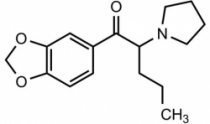 3,4-methylenedioxypyrovalerone (MDPV)
3,4-methylenedioxypyrovalerone (MDPV)NIDA research published in today’s Neuropsychopharmacology shows that MDPV, a synthetic chemical commonly found in the drugs referred to as “bath salts,” is potentially more dangerous than cocaine when tested in rodents. In this study, MDPV prolonged the effects of two neurotransmitters, dopamine and norepinephrine (by blocking reuptake at brain nerve cells) and produced hyperactivity, rapid heart rate and increased blood pressure - highly dangerous symptoms.
Though this study was done in rodents, these results could explain why these substances are addictive and highly dangerous in humans, as indicated by reports that MDPV is the chief substance found in the blood and urine of emergency room patients who have overdosed on “bath salts.”
For a copy of the study abstract, go to https://www.ncbi.nlm.nih.gov/pmc/articles/PMC3521974/. For a recent interview on “bath salts” with the article’s first author, NIDA staff scientist Dr. Michael Baumann, go to https://www.drugabuse.gov/videos/bath-salts-dr-michael-baumann. For more information on “bath salts” and other emerging drugs, go to www.drugabuse.gov/drugs-abuse/emerging-drugs.
For more information, contact the NIDA press office at media@nida.nih.gov or 301-443-6245.